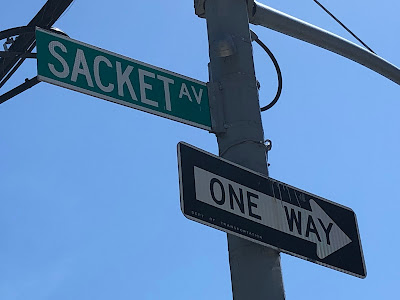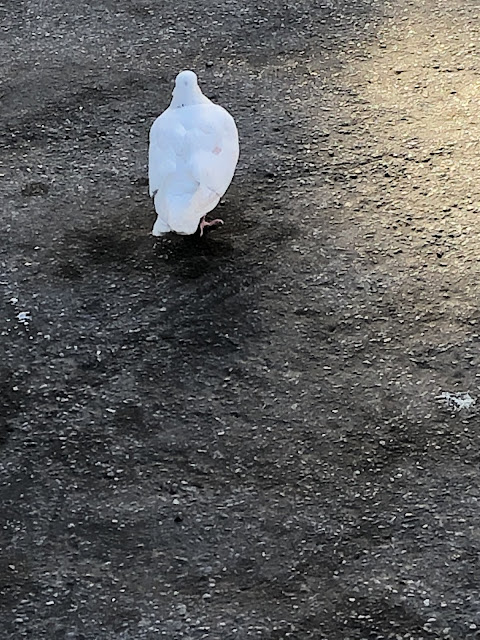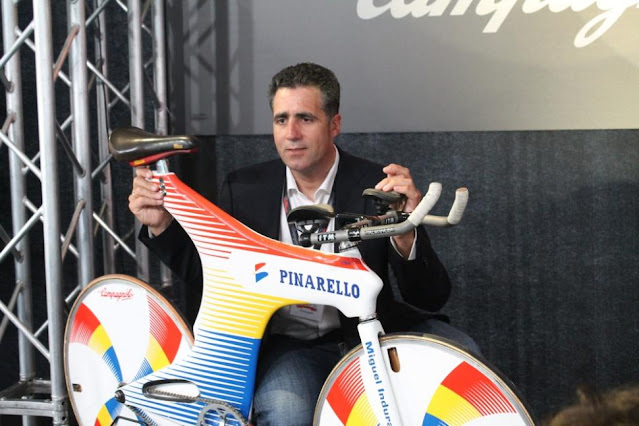Say this three times fast:
In the middle of the journey of my life, I am--as always--a woman on a bike. Although I do not know where this road will lead, the way is not lost, for I have arrived here. And I am on my bicycle, again.
I am Justine Valinotti.
28 April 2024
27 April 2024
Moins de Voitures, Plus de Vélos
A new study confirms an impression I formed during my most recent visits to Paris.
According to L’Institut Paris Région, 11.4 percent of all trips in the City of Light are made by bicycle. In contrast, only 4.2 percent are made by car.
Perhaps even more encouraging for members of the Institut and cyclists, in the banlieues (suburbs) are 14 percent and 11.8 percent respectively. I say “more encouraging” because even though some of those suburbs, especially the ones that border on the city itself, have more access to mass transportation than some major American cities, they still don’t have as much as Paris, where no point is more than 500 meters (about .3 miles, or the equivalent of five or six NYC blocks) from a Métro station.
That availability of trains (and buses) in the central city is reflected in the 30 percent of trips made on them. That the remaining 53 percent are on foot is also not surprising, given Paris’ (deserved) reputation as a “walkable” city.
Still, some believe that mayor Anne Hidalgo—who has done more than any of her predecessors to promote cycling and reduce auto traffic—could have done even more. And, to be fair, she plans to do so, especially with the upcoming Olympic Games, which some see as a showcase for “green” technology in a similar way to how the Exposition (Worlds’ Fair) of 1889 highlighted the technological advances made possible by the “Expo”s centerpiece: the Eiffel Tower.
26 April 2024
Really Going Dutch
Probably the first “normal” thing—besides cycling—I did during the COVID-19 pandemic was to visit the hospital Metropolitan Museum of Art just after it reopened.
Of course, there were restrictions: Visitors had to wear a mask and have their temperatures taken. And, of course, we had to follow social-distancing protocols.
But one thing I loved—along with the Japanese exhibit I went to see—was a service that was provided: a bicycle valet. That person parked your bike in a nice safe spot in the parking garage and gave you a ticket, just as if you had checked a coat or backpack.
Now another venerable institution—actually, annual event that’s been held since 1929–is offering a similar convenience. Cyclists can ride to the event, check their bicycles with a valet, and spend the day exploring, not only a museum, but a large part of a town.
The town in question is holding its festival—Tulip Time—from the 4th until the 19th of May. And, since tulips and bicycles sound so very, very Dutch, you might think that town is in the Netherlands.
Well, it’s not. Rather that town is the Netherlands—or, more precisely, Holland. And it’s located, not among canals, but amidst lakes.
The Holland in question is in the Great Lakes State, i.e., Michigan. Not surprisingly, it was founded by immigrants from the eponymous nation and the Tulip Festival features, not only the colorful flowers, but all things Dutch.
What better way to get there than by bicycle—especially when a valet will park it safely?
24 April 2024
T Time
Yesterday’s ride, though short (about 40 km) was interesting. I had previously ridden most of the streets as segments of other rides. Until yesterday, I didn’t realize how close or connected some of them are. They will, of course, become strands I will weave into new itineraries.
One strange part of the ride began next to the Albert Einstein College of Medicine. (Don’t you feel smarter just reading that?) There begins this street:
A few blocks later, it runs along the Amtrak and Metro North rail lines and becomes this:
So how did Sackett lose one “T”? Did he/she/they not show up for the 4 p.m. ceremony? Or did the railroad’s builders need a “t” to turn a rack of land* into a track?
The street continues along its way beside the railway and, at Hering Avenue in Morris Park, regains its previous identity:
So how did Sackett regain its second “t?” Hmm…The neighborhood, Morris Park, has been an Italian enclave for more than a century. One thing I know about my people is that we drink coffee. (Growing up, I heard, “Tea is for sick people.”) So I imagine it wouldn’t have been difficult to get at least one of us to give up a “t.”
Anyway, I had coffee before the ride. I probably didn’t need it: The sunshine and brisk breezes woke me up!
*—That, I imagine, is how the two sides of land might look with the trench, but without the tracks, running through them.
23 April 2024
Going On A Ride As The Neighborhood Goes
22 April 2024
Who Copes Better?
21 April 2024
The Four-Two-Oh!
As I mentioned yesterday, it was “four-twenty.”
Many theories have circulated about how that combination of numbers, and yesterday’s date, came to be associated with marijuana. One is that “four-two-oh” is the police code for it.* Another is that the date is Bob Marley’s birthday. Neither explanation is true.
Still another explanation is that it’s a reference to Bob Dylan’s song “Rainy Day Women #12 & 35”: Multiply those two numbers and you get 420. While this is somewhat more plausible than the other two stories I mentioned —and the 2016 Nobel Laureate for Literature did, after all, introduce the Beatles to weed— I still doubt it.
The most credible explanation seems to be that a group of California teenagers met at 4:2O in the afternoon to partake of it and other pleasures prohibited by their school—and the law. Supposedly, that group met during the 1970s and one of its members, Dave Reddix, later became a Grateful Dead roadie. (What else can a teenage pothead from California become?) In late 1990, he distributed a flyer (Remember, there was no social media!) inviting Oakland “Deadheads” to smoke with him at 4:20 pm on 4/20 in 1991. That flyer landed in the hands of a “High Times” magazine editor, who printed it in his publication.
So..the folks at Trek could be forgiven for naming one of their models the 420. After all, it was 1981 and they probably didn’t know about Reddix and his troupe of truculent teenagers in Tiburon. Or did they?
*—Cops always say numbers digit-by-digit. So, for example, the 114th Precinct in my old (It still hurts to say that) Astoria neighborhood is “the one-one-four.”
20 April 2024
The Trip And The Day After
18 April 2024
What Was This Driver Doing On The Road?
Someone drives illegally. They* strike and kill a cyclist.
That driver has been sentenced to…
**
…five months in jail. Oh, and the badass judge tacked 40 hours of “community service” and “no more than five years” of probation.
Call me cynical, but I think the judge handed a sentence, light as it is yet still harsher than most for similar infractions because:
- the cyclist was a priest and
- as Paul Walsh, a reporter for the Minneapolis Star-Tribune noted, Trejean D. Curry had “a penchant for driving without a license.”
*—I have used a gender-neutral pronoun to eliminate, as much as I can, any biases.
**—If you were expecting me to say something like “a $50 fine” or “two points on the driver’s license,” I understand.
16 April 2024
Riding With The Flow
Today I rode to, and along, a river.
It wasn’t the Hudson or East River—the latter of which isn’t a river.
And I didn’t leave the city. In fact, I didn’t have to go far from my new neighborhood.
The Bronx River cuts through the New York Botanical Garden, my building’s next door neighbor. Cycling isn’t allowed in the Garden. There are, however, trails along other parts of the only freshwater river in New York City and near its source in Westchester County.
I remember seeing the river decades ago, probably during a trip to the Bronx Zoo. Then, the water was barely visible because of the cars, tires and other refuse that had been tossed into it. Ironically, the building that once housed Lorillard’s snuff factory—one of the river’s first polluters—sits in the Garden, one of the organizations that helped to spur the River’s cleanup about 20 years ago.
I doubt that the water is potable. At least, I wouldn’t drink it. But people enjoy picnics and, I hear, fishing along its banks. And it’s become popular for canoes and kayaks.
Still, there are reminders that it is, after all, in the Bronx.
 |
I continued to ride for another two hours through unfamiliar streets in somewhat familiar areas. Soon, I hope, I will feel more at home, if for no other reasons that places become a part of me when I pedal them.
14 April 2024
Proposal
Some day—perhaps soon—I’ll believe that I’ve moved to the most wonderful neighborhood in the universe. As much as I love my new apartment (even if it is smaller than my old one), its views and its light, and as friendly as my neighbors have been, there are still things I miss about Astoria.
Those things include, of course, my friends—with whom I’ll try to stay in touch. Also, it had, if not the best, then some of the best, of New York: It’s about as close as you can get to Manhattan without being there, but it doesn’t have the self-conscious hipsterism of Williamsburg, Greenpoint or Bushwick.
Oh, and there was the food. I’m finding good eats here, but I still haven’t come across a bakery, let alone one that makes bread or cookies like Parisi’s or bagels like Lots o’ Bagels.
And of course, there are the rides. I could continue to do them, but I would have to ride (or take a train) to get to them. I’m just starting to discover some good routes here, but I’m still in the “It’s not the Fort Totten ride!” stage.
Finally, there are the characters. I’m sure I’ll find them here, but I still think of the ones I just left. They include the guy who hung out by the train station and the stores. He approached me and, probably, every other woman in the neighborhood, with this proposal: “Will you marry me? I’ve got food stamps!”
I have to admit, there are worse—or at least more bizarre—pickup lines.
Soon I will return to regular posting. I have been so busy—and tired—that it seems like a miracle that I actually managed to do two rides—about 25 miles each—that had nothing to do with commuting or errands.
09 April 2024
On The Right Track In Ghent?
When I was in high school, I took my first organized charity bike ride. It was in the Spring of 1976: the tide of the 1970s Bike Boom was ebbing and few (at least compared to today) adults rode bikes. In fact, most had not pedaled since they were kids, if they ever had ridden.
That is what made some of my sponsors hesitant before signing up: They simply could not imagine anyone riding the distance of that ride: 25 miles. Little did they know that I had already done rides twice and three times as long and a “century” was not far in my future.
Of course I finished that ride easily and my sponsors paid up. But the reason I am recalling that ride now is because of a near-tragedy.
The ride crossed railroad tracks. Many riders were inexperienced and almost none wore helmets. (I didn’t!) Someone apparently didn’t realize that cyclists should ride across at a 90 degree angle, preferably while lifting themselves off their seats—or, if the tracks protrude too far off the ground or are wet, simply walk across.
That cyclist’s tire skidded against a rail and when he fell, his head struck the rail. At least that was the story I heard. About a week later, I heard that he’d recovered and was out of the hospital. I wonder, though, whether he suffered any permanent damage that wasn’t detected in those days before CAT scans (as they were called) were widely used.
I got to thinking about that incident, nearly half a century (!) later when I read about how the city of Ghent, Belgium is trying to deal with a similar problem. Ghent and other European cities have trams—similar to the streetcars that once laced many American cities and “light rail” lines that have recently been built in Jersey City and other places. Those conveyances run on a narrower set of rails that are more likely to be at or near pavement level. Also, in some places, cyclists and trams share the same spaces.
So while it is easier to traverse them, it is also easier to miss them or simply not to take the necessary precautions. In Ghent, with a population of around 264,000, bike crashes on tram lines send about 500 cyclists to the hospital every year.
The city is testing a possible solution: Lining the cavity in which the track lies with a new elastic compound. While it won’t sit completely flush with the pavement, there would be enough so that a cyclist could more easily move cross or move out of a tram’s way—and is less likely to get a tire caught between the track and pavement.
08 April 2024
Four Hundred Kilometers From Totality
I didn’t create this Instagram reel. But I was in the vicinity—near the World Trade Center—on Tosca, my Mercian fixed gear bike.
Someone confirmed what I suspected: Many of the people were students or teachers at a nearby high school and college. What could be more educational than seeing a solar eclipse, even if we were about four hundred kilometers away from the path of totality.
07 April 2024
06 April 2024
Which Is Less Likely?
What might you have in common with Miguel Indurain?
Well, not five Tour de France victories—unless you’re Jacques Anquetil, Eddy Mercx or Bernard Hinault.
Otherwise, it’s most likely that if you share any experience with the Basque legend, it’s that of having your bike stolen.
Last month, he was prepping for the six-day Titan Desert mountain bike race when his machine was taken from a van parked outside a hotel in Vilaseca, a Catalonian town where Indurain was staying.
Now, if you’re lucky, you might have another commonality with him: one that might seem almost as rare as five Tour de France victories.
He got his bike back. The local police force reported the return, which they effected.
Now we are, unfortunately, in still-rarer, if not quite as rare as five TdF wins, territory: the constables actually helping someone to reunite with their bike.
Miguel Indurain deserves such cooperation. So do you, should your bike ever be stolen.
05 April 2024
A Quick Break: A Ride
Yesterday I rode—on Tosca, my Mercian fixed gear— for the first time since my move. It was a short trip, past the Garden and Zoo, but it felt good to do something not move- or work-related.
Although I’d previously done some cycling in this area, as Anniebikes says in her comment, there’s more to explore. Even after 21 years of living in Astoria, I found new rides and variations on familiar ones.
My new apartment has nice views and is much lighter and airier than my old place. I wonder: Will the sun steaming in my window energize me to ride more?Will the fog creeping by lure me into winding down the bike lane by the gardens?
02 April 2024
The Latest Stop On My Journey
OK. Now I am going to tell you about the life change which I’d been hinting about during the past couple of weeks.
As you might have guessed, it’s a move: my first since December 2009. And, for the first time since August 2002, I am not living in Astoria.
This photo from my 13 March post is one view from my new apartment: the Conservatory of the New York Botanical Gardens.
I am now living up the block from the Gardens’ Bedford Park Gate. If I look in another direction, I see the Fordham University and Prep School campuses and, in the distance, the Manhattan skyline.
The neighborhood seems to be a racially and ethnically mixed working-to-middle-class area, There are stores and restaurants nearby. Although they carry different items and serve different foods, they remind me of what I encountered when I first moved to Astoria.
I must say, though, that I haven’t seen nearly as many cyclists—and, thankfully, motor scooters—as I would encounter on Crescent Street. That, I think, is a lesson in the sociology of urban cycling: Astoria, like nearly Greenpoint and Williamsburg, has grown younger, whiter and more self-consciously hip. Perhaps I will—consciously or not—plant seeds of cycling culture as I pedal in and out of, and around, the neighborhood.
So why have I moved to Bedford Park, Bronx? Do you promise not to tell anyone?
I am now in a senior citizens’ apartment.
If you’ve been reading this blog for a while, you might’ve guessed that I was in or near the age range for such a thing. For several years,’I’ve been applying for one and my name finally came up.
Whatever my housing situation, I do not plan to change the name of this blog. As I’ve said in earlier posts, whatever my age, I am in the middle of my life as long as I don’t know when it will end. And, as long as I keep on cycling, I don’t think I’ll be anywhere near the end of my journey.


























